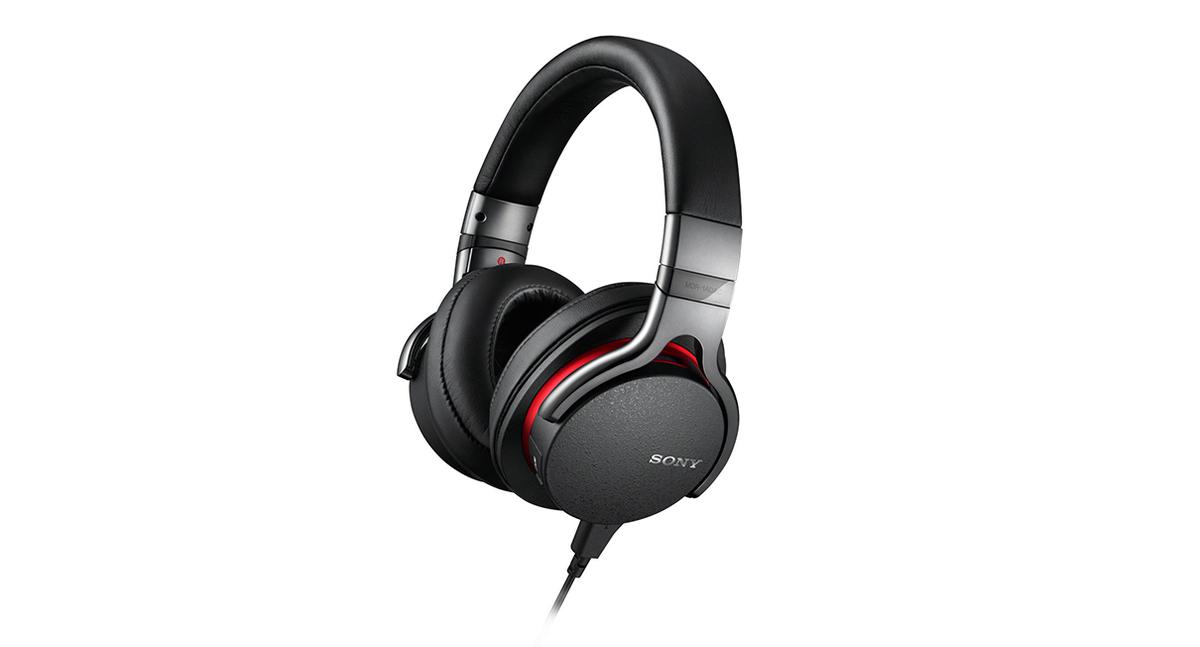There are few things more enjoyable than kicking back with a nice drink, tuning the world out, and listening to some music. Unless of course you have bad hardware, in which case, your favorite tracks can sound like nails on a chalkboard. You might think that a good pair of headphones is enough, and sure, they do make a difference, but they can only do so much. Sony, one of the most trusted names in audio, steps up to the plate with another pair of cans, the MDR-1ADAC, and we got to take it out for a spin.
Design: 4.5/5
These Sony headphones leave little doubt as to their heritage. Black with a soft, metallic red trim give it a serious look that is absent from a lot of similar gear this day. It’s not a toy, and looks nothing like one. The headband is done in a very soft, faux leather, but appear to be plastic underneath. It has swivels that allow the cups to twist 90 degrees, keeping the headphones flat for storage, and though the cups themselves are metal, the swivels are plastic, albeit thick and heavy. The power button and ports are all located on the left cup, while volume control resides on the right. It’s about as handsome as you’re going to get. Understated, but not bland.
Hardware: 4.5/5
Inside every digital music player, there exists a digital-to-analog converter (DAC) which turns the ones and zeroes to electrical signals that make your headphones sing. Most small devices, such as phones, have tiny little DACs to enable them to fit right on the board. These headphones, however, have their own DAC built-in. Dedicated hardware is always better than hardware meant to multi-task, and these cans are no exception.
The cans come with 40 mm drivers, which are about standard for devices this size. The cups are extremely soft and comfortable, and allow hours upon hours of comfort. Because it was built to primarily accept a digital connection, included in the box are cables for connecting to USB, microUSB, Lightning(!!), and Walkman cables. Analog purists do have their 3.5 mm jack available, though this bypasses the internal DAC completely, and you have to open up a flap to access it.
User Experience: 4.5/5
The first thing I have to say about these headphones is that they are just so incredibly comfortable. I didn’t realize how much I had been putting up with until I put these on. This is no surprise, as the plain old MDR-1 is the same design, and might have been the most comfortable headphones I had ever tried. This is going to sit on your head and stay there all day, and you won’t have a word of complaint, save perhaps for the head, if you aren’t in a nice, chilly room.
Secondly, I appreciate all the cables included. I do frequently output audio from my phone’s microUSB port, to get a clean digital signal, and being able to interface that with a good set of cans is a godsend with no additional hardware required. This is an extra bonus for iPhone 7 users, as the included lightning cable lets you listen to your audio without the need for a dorky dongle.
As expected, sound quality from the MDR-1ADAC is superb. Dinky little DACs inside your mobile phones are generally adequate, but if you really want to get the most detail from your lossless tracks, you’ll need an external DAC. While the MDR-1ADAC isn’t exactly a dedicated DAC, it gets the job done right. Sound staging is great for closed headphones, and it doesn’t drown everything out in a heaping serving of bass. The deep thump of the bass drum is fast and powerful, but doesn’t drown out mids, such as in Jeff Buckley’s Lover, You Should Have Come Over. It could use a bit more brightness in the crash, but that might just be down to personal preference.
In Lana Del Rey’s Video Games, the dreamy echo in the background really pops, and while I have had issues with this track breaking up at the more powerful parts of her vocals (probably due to a mastering issue), it’s great for bringing out the brightness of the high mids. To really get into the bass, I queued up James Blake’s Limit to Your Love, and got an earful. This confirmed just how fast and powerful the bass response is. This track clearly exposes weaknesses in a pair of headphone’s bass, but the MDR-1ADAC did superbly—tame, but not underpowered.
Battery life on DAC mode is rated at eight hours, though I have not had to go out of my way to charge them, since using the USB input from a PC also charges it. Trying to use it with a mobile phone on USB output failed to drain the battery even after a whole day at my desk, about six hours, and should the battery run dry, you can always switch to passive mode and your device’s 3.5 mm jack.
Value: 4.5/5
This is a specialized piece of kit. Should you be looking for a comfortable pair of headphones, this certainly fits the bill, though it really shines with digital input, rather than through a 3.5 mm analog jack. At about PHP 10,000, it’s actually a great deal, considering you get both a great set of cans, and a capable DAC. Just make sure you make the most of it.
Bottomline:
Great performance, not a bad price, and loads of comfort. What’s not to like?

Also published in GADGETS MAGAZINE December 2016-January 2017 Issue.
Words by Ren Alcantara
